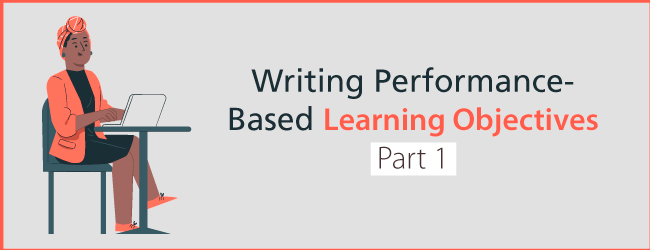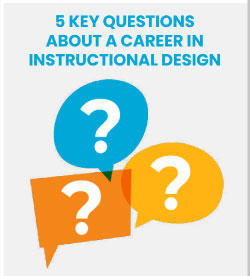
There are at least two categories of performance-based learning objectives based on their purpose. One type of learning objective is for internal use—the design team, client and subject matter expert. The other type is for the audience members. If designers would write different learning objectives for each category, the world would be a better place. This is because internal learning objectives tend to be too technical and de-motivating for your eLearning audience.
Writing Performance-based Learning Objectives
In classical instructional design, the instructional designer starts with a clear overall instructional goal. From this, the designer performs an instructional analysis to determine the content and skills the learner requires to reach this goal. Using the analysis, the designer then writes performance-based learning objectives. Textbooks tell us that objectives must be measurable and must describe the learning outcome in three or four parts (some combine the audience with the behavior). The following is known as the ABCD method.
- Audience: Identify the target audience (Example: cat owner)
- Behavior: What will the target audience member demonstrate. This should be measurable and observable. (Example: Dispense a pill with a medicine dispenser into the cat’s mouth)
- Conditions: In what situation, context or condition will this will be demonstrated? (Example: Given a large, snarly cat)
- Degree: How will the behavior need to be performed (Example: The cat swallows the pill without scratching the owner.)
Putting this all together, here is an example of a four-part learning objective:
Given a large, snarly cat, the cat owner will dispense a pill into the cat’s mouth with a medicine dispenser so that the cat swallows the pill without scratching the owner.
Taking Shortcuts
The ABCD method is an effective approach if you need a lot of detail and if you are new to instructional design. One good thing is that this approach basically tells you how to write your test items. That’s great when you are so pressured to meet a deadline that you barely have time to think.
On the other hand, if you want a shortcut, many people simply include a portion of the full objective, such as:
Dispense a pill into the cat’s mouth with a medicine dispenser.
However you write your performance objectives is fine as long as you are developing solid and effective learning experiences. I don’t recommend skipping performance objectives altogether, because without them, you may lose the focus on performance. You may go down unintended paths that won’t lead to the original outcome.
Purpose of Writing Internal Objectives
The real purpose of writing the internal type of performance-based learning objectives is so designers can:
- Ensure participants meet the goal of the learning experience
- Confirm that no content slips through the cracks and no extraneous content is added
- Provide clarity for practice activities and testing
- Communicate the content to clients, subject matter experts and the development team
- Wrap their minds around the content to understand its scope
- Use the big-picture view to understand what themes, interactivity and engagement strategies can work
- Logically order the content (this can be done in an instructional analysis which many people don’t do)
- Organize the content into chunks, topics, lessons, units, modules, etc.
Performance-based Objectives for the Audience
In an effort to motivate the audience, you can rework your objective into a simple scenario or a statement that let’s them know why it’s relevant to the participant. Using the examples above, you might write:
- Does your sweet cat turn vicious when it has to take medicine? In this lesson, you’ll learn how to dispense a pill to your cat without getting mauled.
- Want to find out how to give your cat a pill the easy way? Click Continue.
In the next article of this series, I’ll discuss ways to make sure your objectives are measurable. Then after that, you can look forward to a post about how to motivate your audience with exciting objectives (or at least not too boring). Why, this is becoming a three-part sequel, just like a bad movie.
If you found this topic interesting and helpful, please pass it on to a friend. Thanks!
Related Articles:
Writing Performance-based Learning Objectives: Part 2
Writing Performance-based Learning Objectives: Part 3
If you want to find out more about a career in instructional design, download my quick read eBook below.


Leave a Reply